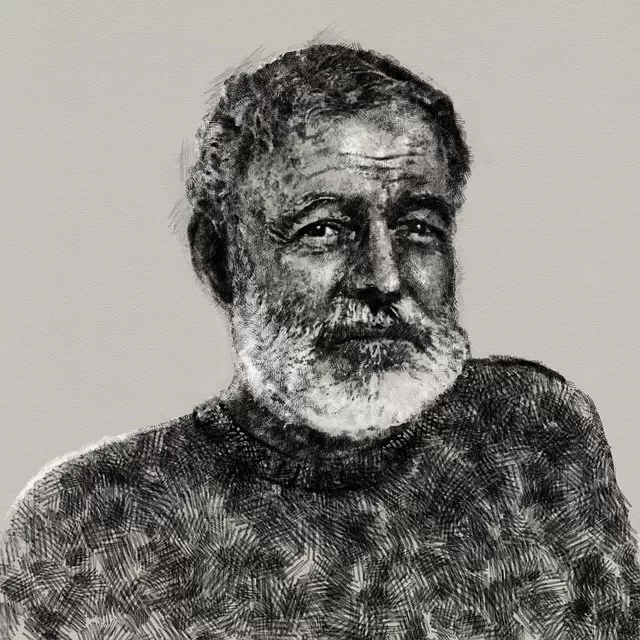The HemingWAY
Where words are carefully chosen to craft tales that captivate and inspire. One name stands out among the rest: Ernest Hemingway. Known for his adventurous spirit and raw writing. Hemingway left an indelible mark on American literature.
Born in 1899, Hemingway’s life was as compelling as his novels. From his early days as a journalist in World War I to his love for travel and safaris. His experiences shaped the themes and characters that would come to define his work.
But Hemingway’s impact extends beyond his adventures. With works like “The Old Man and the Sea,” “A Farewell to Arms,” and “For Whom the Bell Tolls,” he brought a new level of authenticity and simplicity to storytelling. Hemingway’s concise prose and focus on the human condition continue to resonate with readers around the world.
Early life and influences
Ernest Hemingway was born on July 21, 1899, in Oak Park, Illinois, a suburb of Chicago. He was the second of six children born to Clarence Hemingway, a physician, and Grace Hall Hemingway, a musician. From a young age, Hemingway was exposed to a diverse range of influences that would shape his literary career.
Growing up in a middle-class household, Hemingway developed a deep appreciation for the natural world. His father, an avid outdoorsman, took him on hunting and fishing trips, instilling in him a love for adventure and exploration. This connection with the natural environment would become a recurring theme in Hemingway’s writings, where he often used the wilderness as a backdrop for his characters’ struggles and journeys.
Hemingway’s early exposure to literature and the arts also played a significant role in his development as a writer. His mother, a skilled pianist and singer, encouraged him to explore the world of music and the arts, which fostered his innate creativity and appreciation for the power of language. Additionally, Hemingway was an avid reader from a young age, devouring works by authors such as Mark Twain, Stephen Crane, and Gustave Flaubert, whose influence can be seen in Hemingway’s distinctive style.
Hemingway’s writing style and themes
Hemingway’s writing style is renowned for its simplicity, conciseness, and emotional restraint. He pioneered a minimalist approach to storytelling, often using short, declarative sentences and sparse descriptions to convey complex emotions and ideas. This style, known as the “Hemingway Iceberg,” was a deliberate choice to allow the reader to fill in the gaps and draw their conclusions, rather than being overwhelmed by excessive detail.
At the heart of Hemingway’s writings are themes of masculinity, the human experience, and the search for meaning in a chaotic world. His protagonists often grapple with themes of mortality, the futility of war, and the pursuit of personal fulfillment. Hemingway’s works are characterized by a sense of stoicism and a fascination with the human condition, exploring how individuals confront and cope with the challenges of life.
Hemingway’s unique writing style and thematic preoccupations have had a lasting impact on American literature. His influence can be seen in the works of subsequent generations of writers, who have adopted and adapted his minimalist approach to storytelling. Hemingway’s legacy has also extended beyond the literary realm, with his iconic persona as a rugged, adventurous figure becoming a cultural touchstone in its own right.

Major works by Ernest Hemingway
Throughout his prolific career, Ernest Hemingway produced a remarkable body of work that has become essential reading for literature enthusiasts around the world. Some of his most celebrated and influential works include:
“The Sun Also Rises” (1926): Considered Hemingway’s first major novel, “The Sun Also Rises” is a captivating exploration of the disillusionment and aimlessness experienced by a group of American and British expatriates in the aftermath of World War I. Set against the backdrop of the annual running of the bulls in Pamplona, Spain, the novel covers themes of masculinity, love, and the search for purpose in a world that has been forever changed by the ravages of war.
“A Farewell to Arms” (1929): Hemingway’s second novel, “A Farewell to Arms,” is a poignant love story set against the backdrop of the Italian Front during World War I. The novel follows the journey of an American ambulance driver, Frederic Henry, and his doomed romance with a British nurse, Catherine Barkley, as they navigate the horrors of war and the fragility of human existence.
“For Whom the Bell Tolls” (1940): Widely regarded as one of Hemingway’s masterpieces, “For Whom the Bell Tolls” is a powerful exploration of the Spanish Civil War. The novel follows the story of Robert Jordan, an American volunteer fighting alongside the Republican forces, as he is tasked with blowing up a strategic bridge. Through Jordan’s experiences, Hemingway delves into themes of loyalty, sacrifice, and the universal human struggle against oppression.
“The Old Man and the Sea” (1951): Hemingway’s final major work, “The Old Man and the Sea,” is a novella that won him the Pulitzer Prize for Fiction in 1953 and was a significant factor in his Nobel Prize in Literature the following year. The story follows the journey of an elderly Cuban fisherman, Santiago, who embarks on a solo fishing expedition and struggles against a giant marlin, a metaphor for the human struggle against the forces of nature and the passage of time.
These works, among others, have cemented Hemingway’s reputation as one of the most influential and iconic American writers of the 20th century. His unique style, thematic depth, and enduring impact on literature continue to captivate readers and inspire writers around the world.
Hemingway’s impact on American literature
Ernest Hemingway’s influence on American literature cannot be overstated. His distinctive writing style, characterized by its simplicity, directness, and emotional restraint, has had a profound impact on generations of writers who have sought to emulate his approach to storytelling.
Hemingway’s minimalist style, often referred to as the “Hemingway Iceberg,” where he deliberately omits certain details and allows the reader to fill in the gaps, has been widely imitated and adapted by subsequent authors. This technique, which requires the reader to actively engage with the text and draw their conclusions, has become a hallmark of modern American literature.
Moreover, Hemingway’s thematic preoccupations, particularly his exploration of masculinity, the human experience, and the search for meaning in a chaotic world, have resonated with readers and writers alike. His works have inspired countless authors to grapple with similar themes, often using Hemingway’s style as a starting point for their unique literary voices.
Beyond his direct influence on literary style and themes, Hemingway’s larger-than-life persona has also had a significant impact on the cultural landscape. His image as a rugged, adventurous figure, a man’s man who embraced the thrill of hunting, fishing, and bullfighting, has become a cultural archetype that continues to captivate readers and the public imagination.
Hemingway’s enduring legacy can be seen in the countless writers who have been inspired by his work, from the Beat Generation authors of the 1950s to the contemporary literary giants of today. His impact on American literature is undeniable, and his influence will continue to be felt for generations to come.
Hemingway’s adventures and experiences

Ernest Hemingway’s life was as adventurous and captivating as the stories he wrote. From his early days as a journalist covering the First World War to his later explorations of Africa and the Caribbean, Hemingway’s experiences shaped the themes and characters that would come to define his literary oeuvre.
As a young man, Hemingway served as an ambulance driver during World War I, an experience that profoundly shaped his perspective on the human condition and the futility of war. His time on the Italian Front, where he was wounded by mortar fire, would later be reflected in his novel “A Farewell to Arms,” a poignant exploration of the impact of war on individuals and their relationships.
After the war, Hemingway’s thirst for adventure and exploration only grew. He traveled extensively throughout Europe, immersing himself in the vibrant expatriate community in Paris and developing a deep appreciation for the culture and cuisine of the continent. These experiences would inform the setting and atmosphere of many of his early works, including “The Sun Also Rises” and “A Moveable Feast.”
Hemingway’s love for the natural world and his fascination with the thrill of the hunt led him to embark on numerous safaris in Africa, where he indulged his passion for big-game hunting. These expeditions not only provided him with material for his writings but also shaped his understanding of the human relationship with the natural environment, a theme that would become central to his work.
In the later years of his life, Hemingway continued to seek out new adventures, traveling to Cuba, where he lived for many years, and exploring the rugged landscapes of the Caribbean. It was during this time that he wrote some of his most acclaimed works, including “The Old Man and the Sea,” a novella that would cement his legacy as one of the greatest American writers of the 20th century.
Hemingway’s adventurous spirit and his willingness to immerse himself in diverse cultural and natural environments were integral to his literary success. His experiences, both in war and in peace, provided him with the raw material that he would transform into the timeless stories that have captivated readers for generations.
Hemingway’s relationships and personal life
Ernest Hemingway’s personal life was as captivating and complex as his literary works. Throughout his life, he navigated a series of tumultuous relationships and faced numerous personal challenges that shaped his creative output and public persona.
Hemingway’s first significant relationship was with his first wife, Hadley Richardson, whom he married in 1921. The couple lived in Paris during the 1920s, where Hemingway became part of the influential group of expatriate writers known as the “Lost Generation.” However, their marriage was marked by infidelity, and the two ultimately divorced in 1927.
Hemingway’s subsequent marriages, to Pauline Pfeiffer, Martha Gellhorn, and Mary Welsh Hemingway, were equally turbulent, each with its own unique set of challenges and personal dramas. Hemingway’s relationships were often characterized by his domineering personality, his struggles with mental health, and his insatiable appetite for adventure and risk-taking.
Despite the personal turmoil, Hemingway’s relationships with these women had a profound impact on his writing. His wives and lovers often served as inspiration for the strong, independent female characters that populated his novels and short stories, reflecting Hemingway’s complex views on gender and power dynamics.
Hemingway’s personal life was also marked by a series of physical and mental health issues, including depression, alcoholism, and a series of injuries sustained during his various adventures. These challenges, combined with the intense public scrutiny that came with his fame, took a significant toll on Hemingway’s well-being and contributed to his eventual suicide in 1961.
Despite the personal struggles, Hemingway’s relationships and experiences continued to shape his literary output, with the themes of love, loss, and the human condition permeating his writings. His complex personal life, in many ways, became an extension of the themes and characters that he so masterfully crafted on the page, cementing his legacy as one of the most influential and captivating figures in American literature.
Hemingway’s awards and recognition
Throughout his illustrious career, Ernest Hemingway received numerous accolades and awards that recognized his immense contributions to American literature. His works were widely acclaimed during his lifetime, and his literary achievements continue to be celebrated and studied by scholars and readers alike.
Perhaps Hemingway’s most prestigious honor was the Nobel Prize in Literature, which he was awarded in 1954. The Nobel Committee praised Hemingway for his “powerful, style-forming mastery of the art of modern narration,” acknowledging his unique and influential approach to storytelling.
In addition to the Nobel Prize, Hemingway was the recipient of the Pulitzer Prize for Fiction in 1953 for his novella “The Old Man and the Sea.” This work, which tells the story of an elderly Cuban fisherman’s struggle against a giant marlin, was widely regarded as a masterpiece and a culmination of Hemingway’s literary genius.
Hemingway’s other accolades include the O. Henry Prize, which he won in 1923 for his short story “Up in Michigan,” and the National Book Award for Fiction, which he received in 1950 for “The Old Man and the Sea.” These awards not only recognized Hemingway’s literary prowess but also solidified his reputation as one of the most important American writers of the 20th century.
Beyond these formal awards, Hemingway’s works have been the subject of countless critical analyses and scholarly interpretations, further cementing his legacy as a literary icon. His novels, short stories, and non-fiction writings have been translated into numerous languages and have been the focus of countless academic studies, ensuring that his influence will continue to be felt for generations to come.
Hemingway’s recognition and acclaim are a testament to the enduring power of his writing and the lasting impact he has had on the literary landscape. His awards and honors serve as a reminder of the profound and lasting legacy he has left behind, one that continues to inspire and captivate readers around the world.
The enduring legacy of Ernest Hemingway
The legacy of Ernest Hemingway transcends the literary realm, reaching far beyond the confines of the written word. His impact on American literature, and indeed, on the broader cultural landscape, is undeniable and continues to be felt to this day.
Hemingway’s distinctive writing style, characterized by its simplicity, directness, and emotional restraint, has become a hallmark of modern American literature. His minimalist approach, which allows the reader to fill in the gaps and draw their conclusions, has inspired countless writers to experiment with new and innovative ways of storytelling.
But Hemingway’s legacy extends far beyond the technical aspects of his craft. His thematic preoccupations, particularly his exploration of masculinity, the human experience, and the search for meaning in a chaotic world, have resonated with readers and writers alike, making his works timeless and universally relevant.
Moreover, Hemingway’s larger-than-life persona, with its rugged, adventurous spirit and its iconic status as a cultural archetype, has become a central part of his enduring legacy. His image as a man’s man, a figure who embraced the thrill of the hunt and the challenges of the natural world, has become a touchstone of American popular culture, inspiring countless imitations and adaptations.
Today, Hemingway’s works continue to be read, studied, and celebrated by scholars, students, and general readers alike. His novels, short stories, and non-fiction writings remain staples of literature curricula around the world, ensuring that his influence will continue to be felt for generations to come.
As we reflect on the life and legacy of Ernest Hemingway, it becomes clear that his impact on American literature and culture is truly unforgettable. Through his timeless stories, his distinctive style, and his larger-than-life persona, Hemingway has left an indelible mark on the literary landscape, cementing his place as one of the most significant and influential American authors of the 20th century.
Remembering Ernest Hemingway
As we bid farewell to the life and legacy of Ernest Hemingway, we are left with a profound sense of gratitude and admiration for the immense contributions he has made to the world of literature. Through his captivating stories, his innovative style, and his unwavering dedication to the craft of writing, Hemingway has etched his name in the annals of literary history, forever shaping the trajectory of American literature.
Hemingway’s life, marked by adventure, personal struggles, and a relentless pursuit of the human experience, has become a testament to the power of the written word. His works, from the poignant love story of “A Farewell to Arms” to the timeless classic “The Old Man and the Sea,” have touched the hearts and minds of readers across generations, transcending the boundaries of time and place.
As we remember Ernest Hemingway, we are reminded of the enduring impact that a single individual can have on the world around them. Through his words, his experiences, and his unwavering commitment to his craft, Hemingway has left an indelible mark on the literary landscape, inspiring countless writers to follow in his footsteps and explore the depths of the human condition.
In the end, the legacy of Ernest Hemingway is not just about the accolades and awards he received, but rather the profound and lasting influence he has had on the way we read, write, and understand the world around us. His stories, his style, and his larger-than-life persona have become a part of the cultural fabric of America, a testament to the power of the written word to shape and transform the human experience.
As we bid farewell to this literary giant, let us remember the words of Hemingway himself, who once said, “The world breaks everyone, and afterward, many are strong at the broken places.” It is in these broken places, these moments of vulnerability and resilience, that Hemingway’s legacy will continue to resonate, inspiring generations of readers and writers to come.












































































































